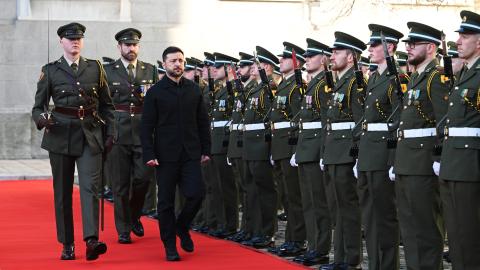Executive Summary:
- Battlefield assessment: Russia took advantage of heavy fog to gain additional ground in the embattled city of Pokrovsk. Meanwhile, the Ukrainian military withdrew from multiple settlements near Zaporizhzhia in the face of Russian offensive operations.
- Drone warfare update: Ukraine’s STING drone-intercepting loitering munition has scored more than one thousand kills of Russian-operated Shahed drones, signaling a potential shift in the currently offense-dominated aerial environment.
- What to watch for: (1) Can Ukraine maintain its logistics routes near Pokrovsk? (2) Will Kyiv’s forces withdraw further or counterpunch in Zaporizhzhia?
1. Battlefield Assessment
Last week Ukrainian units faced intense pressure at multiple flashpoints. Kyiv reported that between Monday night and Tuesday night, its forces engaged in some 170 tactical engagements—40 percent of which, according to some estimates, were in or around Pokrovsk.
Russian forces are pressuring the heavily fortified city from an increasing number of axes, conducting offensive maneuvers to encircle Ukrainian combat formations. An open-source intelligence assessment of the area shows that heavy fog is limiting Ukraine’s surveillance and reconnaissance capabilities, which are crucial for defensive operations.
Several hundred Russian troops have already used light vehicles to penetrate Ukraine’s lines of defense and breach the outskirts of the city. Available intelligence suggests that a drone warfare battalion from Ukraine’s 68th Jaeger Brigade has been using first-person-view (FPV) drones to locate and destroy Russian groupings, including small motorbike assault infantry teams.
Ukrainian President Volodymyr Zelenskyy stated that Russia is working to capture the city to signal to the West that supporting Ukraine is futile. Yet Russia’s fight for Pokrovsk has come at a steep cost. Moscow’s forces have borne an average of more than one thousand casualties per day this October and have seen 350,000 servicemen killed in action since January 2025. In all, Russia has suffered more than one million casualties since the start of the war.
Russia blanketed the city of Kupiansk with heavy bombing and drone strikes. Combat operations also continued in the directions of Sloviansk and Lyman despite minimal changes in territory. Unmanned aerial vehicle detachments from Ukraine’s 63rd Mechanized Brigade scored multiple FPV drone kills on Russian combat formations in Lyman.
Russian forces also targeted the civilian population of Kostiantynivka with heavy drone strikes and artillery shelling. Under heavy fire, Ukrainian officials struggled to evacuate the city’s 5,000 remaining citizens. In southern Ukraine, Russian forces also continued to push in the direction of Orikhiv.
Finally, the Ukrainian military has been losing ground at the tactical level on the axis leading to Zaporizhzhia. Ukrainian combat formations were forced to withdraw from defensive positions near the settlements of Novomykolaivka, Okhotnyche, Novye, Uspenivka, and Novouspenivske.
2. Ukraine’s STING Loitering Munition Scores Over One Thousand Drone Kills
Over the past several months, the Ukrainian Armed Forces have rolled out a new drone-intercepting loitering munition known as STING.
A Visual of the STING Counter-Drone System
Image from the Wild Hornets via United24 Media.
Developed by the all-volunteer engineering group the Wild Hornets to counter Iran-designed Shahed drones, STING is a quadcopter-hybrid interceptor equipped with a dome-shaped warhead and a thermal camera. It uses a traditional FPV interface with a high-end digital video link and can be easily paired with ground-control stations. It is reportedly capable of reaching speeds exceeding 100 miles per hour and can operate at altitudes near 10,000 feet.
Since making its combat debut earlier this year, STING has scored more than 1,000 drone kills. In a potentially promising development, Ukraine’s principal combat formations have begun receiving large numbers of these munitions. Ukraine’s defense industry has even demonstrated the drone’s capability in live-fire drills before a high-level European audience: STING systems destroyed Danish target drones during friendly exercises this October.
Such smart and affordable solutions will only grow in importance as Russian drone production increases. Ukraine’s unmanned systems community warns that Russia’s Center for Advanced Unmanned Technologies—known as Rubicon—is expanding production at a pace that Kyiv cannot match.
Rubicon’s rapid growth reflects two advantages: heavy state funding and a structured recruitment pipeline. It is structured to integrate weapons production, deployment, and operations, and Russian youth programs have militarized thousands of 16- and 17-year-olds, training these minors to be drone operators.
Ukraine’s scaled deployment of STING comes at a crucial time for Kyiv as Russia leverages its institutional muscle to rapidly scale its drone warfare operations.
3. What to Monitor in the Coming Weeks
- Logistics routes to Pokrovsk: Ukraine has deployed elite combat formations to the embattled city, including personnel from the 7th Rapid Reaction Corps and Main Intelligence Directorate (GUR). Maintaining a smooth logistics flow is vital for Ukraine’s defensive operations. Heavy fog is a key operational parameter.
- Further withdrawals—or Ukrainian counterpunches—near Zaporizhzhia: In a surprising development last week, Russian pressure forced the Ukrainian military to abandon five settlements near Zaporizhzhia. This report will monitor whether Russia can sustain these gains and move follow-on forces to the area.


















